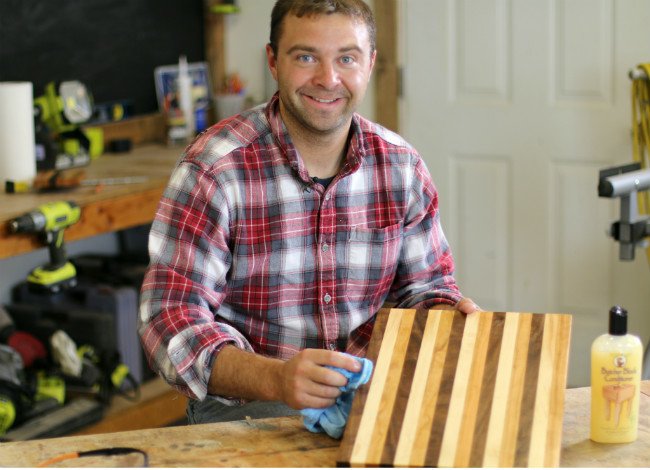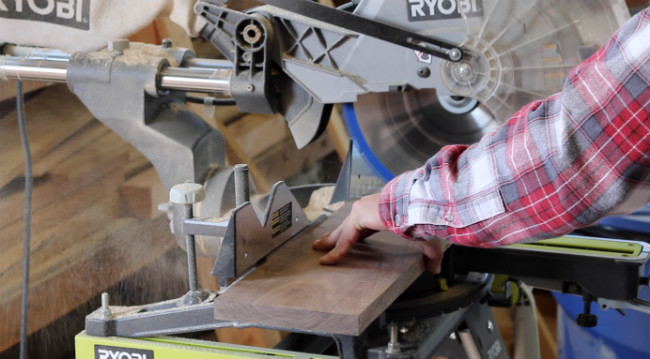Learn how to Make a DYI Butcher Block Cutting Board with DIY Pete. We made a cutting board out of select hardwoods: walnut, cherry, and maple. The final dimension is 12″x16″x3/4″. This is a great DIY project for those just getting into woodworking or for the more advanced as well. This is a quick DIY cutting board project and with only a couple of hours and a few dollars, you can do this too!
Butcher block cutting boards make great gifts for friends and family. Check out the video and step-by-step instructions below.
Supply and Tool List for the Cutting Board
Hardwoods for Cutting Board
1 Walnut board 4″x16″x1″
1 Maple Board 4″x16″x1″
1 Cherry Board 4″x16″x1″
Cost: The hardwoods will vary in cost depending where you live. For the one large cutting board it cost me about $15 for the wood. Since I made another, smaller, cutting board for this project, the wood cost $22 total for all.
Gorilla Wood Glue
Cost: $3 or so at your local hardware store or on Amazon
Mineral Oil Foodsafe Finish/Conditioner
Cost: $8 for a full bottle, this project only uses about 1/10th of the bottle.
Tools
Table Saw
Miter Saw or Circular Saw
Jack Clamp (set of 2) Use my JackClamp coupon code to get $5 off any order over $50 – Code: DIYPETE5
Gorilla Wood Glue
Thickness Planer (optional)
Square, Tape Measure, Pencil, Ear and Eye Protection
Step 1: Clean up the raw boards' ends and sides
You want to work with straight boards for a butcher block build, ensuring the joints will be clean. Start by trimming the sides and ends of your hardwood boards. Trim the sides on a table saw or with a circular saw and straight-edge and trim the ends on a miter saw. Leave the ends of the boards slightly longer than your desired final dimension, as you'll trim it down again later.
Step 2: Cut the boards into 3/4″ Strips
Now, you need to rip all the strips for the butcher block cutting board. The best method for this is by setting your table saw fence to the desired dimension (3/4″ in this case) and ripping the boards. Do this step for all of the walnut, maple, and cherry boards.
Step 3: Organize the Strips and Apply Glue
Once you've ripped the strips to size on the table saw, you can lay them out and decide the sequence or pattern that you like. The walnut and maple darks and lights make for great contrast, while the cherry pleases the eye somewhere in the middle of the spectrum. Once you've organize your pattern, flip all of the boards either left or right to show the end grain.
Apply a generous amount of glue to all of the strips' end grain. I highly recommend Gorilla Wood Glue! Rub the glue in, and spread it with your fingers or with a piece of scrap wood, etc. Flip the strips back over to show the top grain. Stick the glued side of one strip to the dry side of another strip. For the two end pieces, I suggest to add glue to both sides of the strips to ensure a solid joint.
Step 4: Clamp the Strips together and Let Glue Set
Clamp your butcher block cutting board with at least two clamps on either end of the block. Wipe all of the excess glue, both on the cutting board and your workstation, with a damp rag. This will save you time later in the sanding stage and ensures a clean shop! Let the glue set/dry for at least 1 hour or however long your glues' manufacturer recommends.
Step 5: Either Plane or Sand the block
Unless you're able to buy lumber that is exactly the same thickness, each strip of the butcher block cutting board will likely vary and thus the need for planing or sanding. If you have a thickness planer, they make clean, quick, and consistent work out of smoothing down your cutting board. A thickness planer is optimal, but this step can also be completed with an orbital sander and a little elbow grease. If sanding, start with 40 to 60 grit sandpaper to even the strips' thickness. Trim the ends of the butcher block on a miter saw, getting to your final dimensions.
Come through with the orbital sander after planing or sanding the block evenly and do the finish sanding. Sand the block down to 220 or higher, sand all of areas of the block, and ease the edges. Some other advanced options would be to route the edges with a round-over bit, inlay a design or accent strip in the butcher block, and more. Wipe the dust off of the board with a tack cloth or wet rag. Prepare your workstation for finishing.
Step 6: Apply the Food-safe Finish
Cutting boards need to be finished in a food-safe finish. My finish of choice is Howard Products Butcher Block Conditioner. It is a blend of mineral oil, beeswax, and vitamin e and it exceeds US FDA regulations for direct and indirect contact with food. Rub the finish into the butcher block cutting board generously. The end grain of the hardwoods will soak up more of the finish than the top grain, be sure to rub over the whole board. Let this soak into and penetrate the board for 20 minutes, then come through with a clean microfiber cloth and polish the board. You can add rubber feet to the bottom of the board if you'd like.
Step 7: Enjoy your new Cutting Board
I hope you've enjoyed building your butcher block cutting board as much as I did! These are a great DIY project for anyone from beginners to advanced woodworkers. The opportunities and customizations are endless. Enjoy your work! Cheers
















